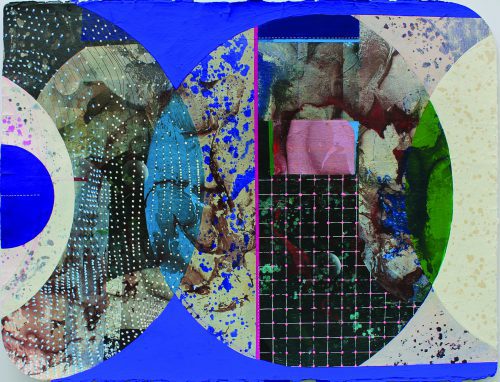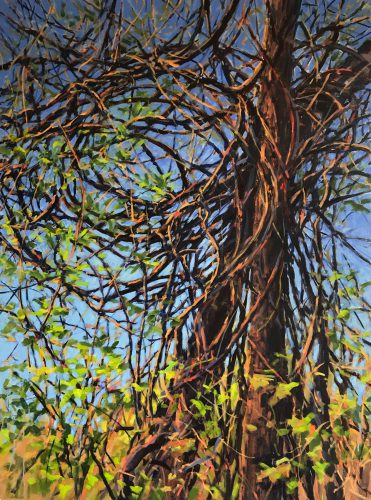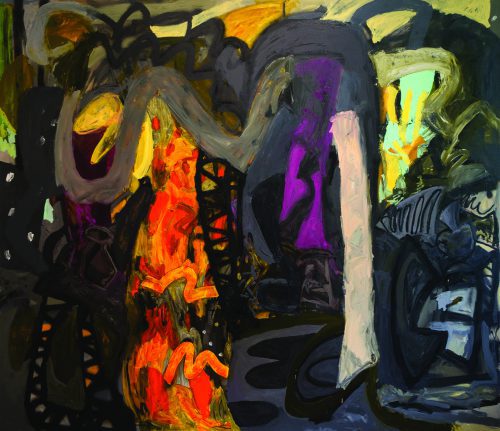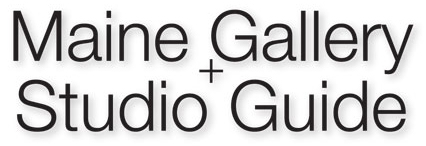
September 13 – December 21, 2019Way Stations features a stunning assortment of new abstract paintings by New York-based artist Joan Belmar. Spherical forms, often filled with transparent textural passages, populate Belmar’s compositions and are often combined with segmented lines, dots, and portal-like constructions. “Circles represent the infinite”, says Belmar, adding that they “suggest, like a Russian doll that contains one inside the other, world or way stations within other worlds.”
Belmar offers multiple vantage points and structures in his compositions. It’s as if we are looking at surface topographies of unnamed planets through a telescope, or perhaps glancing down at outstretched maps to plot routes through unknown terrain. A focal point of the exhibition is an expansive wall showcasing two tondo paintings, each 92 inches in diameter, which were created especially for the UMMA exhibition. These circular works highlight the collage-like approach and layering seen in many of the artist’s compositions—solid blocks and bands of bold color share space with spherical forms that have a pattern overlay of hand-painted dots.

September 13 – December 21, 2019Entangled features a new series of paintings and drawings by Maine-based artist Nina Jerome. Invasive wild grape vines, that Jerome encountered while at a recent artist residency, inspire these exuberant and expressive compositions. Ranging from the monochromatic to vividly colored paintings, the artist has captured the gesture and wild energy of these tangled masses. Jerome states, “the movement and joyful choreography of their entanglement express the variety and excitement of life’s experiences, yet the tangled knots also create obstacles within our interconnected systems.”
A focal point of the exhibition is the large-scale Thicket that is composed of nine individual panels hung in a dramatic grid. Measuring 7 ½ x 7 ½ feet, the work contains a bustling array of overlapping curvilinear lines in bold black with contrasting blue gestural marks. For Jerome the circular forms, “capture the chaos of nature and seems to balance on the edge of beauty and destruction.” In addition to the drawings and monochromatic paintings, the artist also reveals her skill as a colorist. In two striking compositions, Entangled Red and Dance, the artist employs an expressionistic palette—the looping vines are depicted in intense reds while the background is rendered in vivid blues. The works in Entangled provide an open window to Jerome’s creative process. In the exhibition, one sees the evolution of her art from small, spontaneous and spirited drawings to larger and more structured works on canvas for which the artist is most known.

September 13 – December 21, 2019Studio Visit brings together a selection of new works by six notable painters working throughout the United States. Ranging from hard-edged to densely layered compositions, this exhibition showcases each artist’s unique approach to abstraction. Intimate 6 x 8 inch oil paintings share space with boldly colored, large-scale canvases, some of which span eight feet.
Thomas Berding’s (East Lansing, Michigan) information-rich paintings live in a perpetual state “between construction and deconstruction, representation and abstraction, addition and deletion”. There’s a spatial complexity to Berding’s paintings in which his raucous assembly of overlapping shapes, bands, shards, and ambiguous detritus seems to recede into infinity.
Joanne Freeman (New York, New York) captures lighthearted gestures in an assortment of hard-edged compositions. Within Freeman’s bold shapes are colors ranging from vivid-blues to saturated reds. The artist sets up a beautiful tension in which these shapes are arranged in close proximity, but do not touch. In several of her new paintings the weight of the larger forms balances the delicateness of the seemingly malleable, slender, red-orange forms.
Alfredo Gisholt’s (Boston, Massachusetts) oil paintings are populated with eccentric forms captured through spirited, gestural brushstrokes. Gisholt’s compositions are both humorous and ominous in the same instance. A mélange of fractured shapes, curvy lines, and other enigmatic devises share space and invite the viewer to invent narratives while also observing the materiality of paint.
Rachel Hellmann’s (Terre Haute, Indiana) shaped compositions explore the intersection of painting and sculpture while offering an interplay of geometry, light, and color. Crafted from poplar wood, Hellman’s forms are meticulously planed, cut, pieced together, glued, clamped, and sanded. The artist’s painted bands depict color relationships that range from monochromatic to vividly bold; the arrangement of the elements is in direct response to the unique qualities of each sculpted form.
In Suzanne Laura Kammin’s (Newark, New Jersey) abstract oil paintings, hard-edged forms unite with transparent gestural brushwork. In compositions that bring to mind the crisp, spray-painted marks of certain types of graffiti, the artist has employed a dynamic palette ranging from vibrant reds and saturated yellows to bold greens. Kammin states that she contrasts “smooth, minimal shapes of pure color against distressed and improvisatory passages to create a sense of expansiveness, magic, and mystery.”
At first glance, Matt Phillips’ (New York, New York) paintings may appear to be rooted solely in rigid geometric abstraction, but within each defined shape are complex and rich passages achieved through delicate brushwork. Phillips’ fractured forms seem to be in a state of fluctuation, as if one is looking at shifting patterns and light through a kaleidoscope.
Categories: Announcement, Bangor, museum
Tags:

